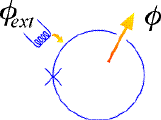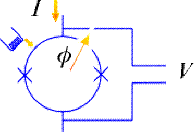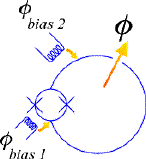Devices & Labs

Superconducting Devices in MQC
Josephson Junction
A JJ is a superconducting device consisting of two superconducting electrods separated by a thin insulating layer. Its V-I characteristic is non linear and hysteretic (if the intrinsic dissipation is low).

rf-SQUID
A rf-SQUID is a superconducting ring interrupted by a Josephson Junction. In
spite of its macroscopic nature (it contains about 10^11 Cooper pairs), according
to standard theories, its behaviour is described by Quantum Mechanics.
The typical observable in this system is the magnetic flux threading the ring
(or, equivalently, the current circulating in the ring). For appropriate bias
magnetic flux the rf-SQUID presents a symmetric double well potential with
two distinct minima. If the temperature is sufficently low (only few energy
levels occupied) the state of the system at time t is essentially given by
the linear superposition of two distinct (apart a little correction) states
|A> and |B>:
|t> = a(t) |A> + b(t) |B>
The wavefunctions of |A> and |B> present narrow peaks around the values
fA and fB respectively, so that the result of a measurement of the magnetic
flux can give essentially one of the two possible values A (state |A>) or
B (state |B>).
The probabilities to have a result fA (or fB) at a time t starting from a state
fA (or fB) at t=0 are given by the squared modules of the coefficients a(t)
and b(t). They evolve in time with damped oscillations (the damping is due to
the decoherence effect caused by the coupling with the enviroment). In absence
of damping is:
P(A,t | A,0 )=P( B,t | B,0 )=cos(w t)
P(A,t | B,0 )=P( B,t | A,0 )=sin(w t)
while, with damping we have damped oscillation, with probabilities going to 1/2 for t going to infinity.

dc-SQUID
A dc-SQUID (switch) is a superconducting ring interrupted by a couple of Josephson Junctions. It is biased with an external current Ibias, and is inductively weakly coupled with the rf-SQUID. With appropriate construction parameters it behaves as a switch depending on the input magnetic flux f:
a) For f greater than a threshold value fS the dc-SQUID becames a normal conductor.
In this case there is a strong back-action.
b) For f lower than fS the dc-SQUID remains superconducting. In this case, ideally,
there is no back action on the rf-SQUID.
This device is used to perform an observation on the rf-SQUID. One turns on the dc-SQUID by giving a Ibias different from zero only for a very short time, and observe the voltage across the rf-SQUID: If the flux from the rf-SQUID is fB, the dc-SQUID becomes a normal conductor. One does not use this kind of results because of the strong back-action that disturbs the evolution of the rf-SQUID and destroys its coherence. On the contrary, if the flux from the rf-SQUID is fA, the dc-SQUID remains superconducting. In this case there are no variations in the dc-S, and the rf-SQUID is not disturbed.

double rf-SQUID
A double rf-SQUID is similar to a rf-SQUID in which the single Josephson Junction is replaced by a dc-SQUID. The behaviour of this device is similar to that of a normal rf-SQUID, but now it is possible to tune the SQUID parameters, for example the potential barrier hight.

The Lab
Here's the Gallery, enjoy the visit!



![]()